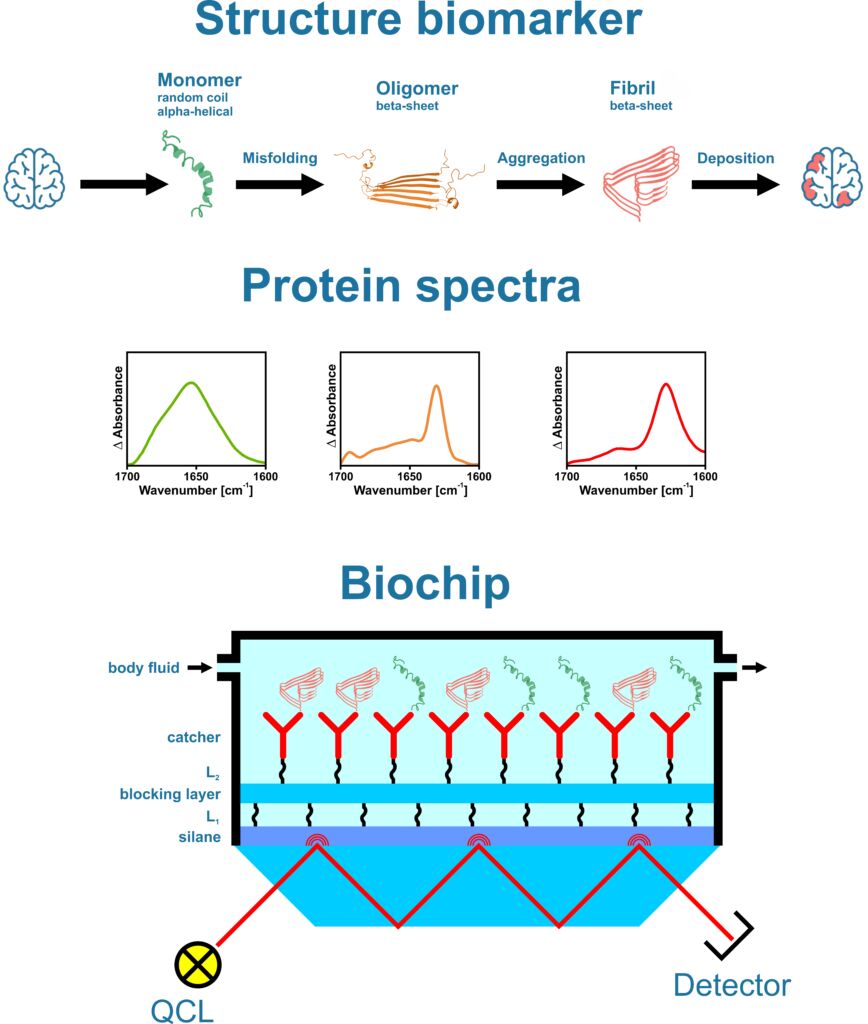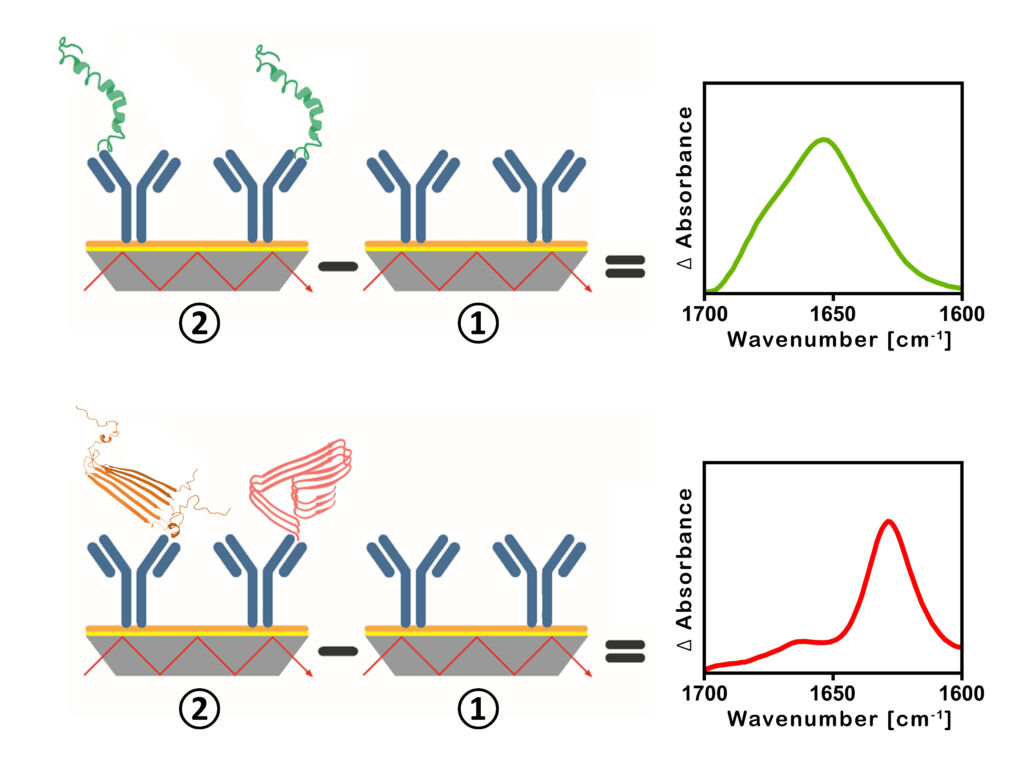An innovative principle = a forward-looking platform for diagnostics in neurodegeneration.
-
Reliable prognosis for early-stage risk in Alzheimer's disease
-
Reliable differentiation between different forms of a disease
-
More than 10 years ahead in prevention and therapy
-
A blood sample is all that is required



Differential spectroscopy
Infrared spectroscopy is an analytical method used to detect small changes between two states of a sample. It involves subtracting two absorption spectra from each other to obtain a difference signal. In the betaSENSE method, the signal from the previously functionalized biochip is subtracted from the sample signal. This makes the additional protein signal (amyloid-beta or alpha-synuclein) visible on the surface. Different secondary structures absorb differently in the infrared, allowing for classification.
Our procedure using Alzheimer’s disease as an example.
What begins with a bodily fluid test leads, thanks to the betaSENSE procedure, to the possibility of detecting various neurodegenerative diseases before symptoms appear. The procedure is explained step by step using Alzheimer’s disease as an example.
So-called amyloid beta deposits (Aβ) in the brain, also known as plaques, are typical of Alzheimer's disease. These plaques are a consequence of the misfolding of this protein, which begins at the molecular level 15-20 years before the visible “clumping” in the brain. To determine possible early changes, special antibodies are used to filter Abeta proteins out of body fluids in order to examine their structure.
Infrared rays measure the structure of the extracted Aβ proteins. This is done using the patented immuno-infrared sensor. This is an innovative new platform technology developed by betaSENSE. Normal (healthy) and misfolded (diseased) proteins absorb at different frequencies. The maximum band directly indicates the risk of developing Alzheimer's dementia later in life.
The more misfolded proteins the measurement reveals, the higher the risk of developing Alzheimer's disease. A traffic light system classifies the values: values in the green range indicate no risk, values in the yellow range indicate a slightly increased risk, and values in the red range indicate a significantly increased risk of developing Alzheimer's dementia in the future.
Other degenerative diseases of the central nervous system, such as Parkinson's or ALS (amyotrophic lateral sclerosis), also show initial signs of misfolding of certain marker proteins. To detect them, the antibodies on the sensor platform are replaced accordingly in order to extract relevant proteins from body fluids.
What begins with a bodily fluid test leads, thanks to the betaSENSE method, to the possibility of detecting various neurodegenerative diseases before symptoms appear. The method is explained step by step using Parkinson’s disease as an example.
A characteristic feature of Parkinson's disease is the misfolding of the key protein alpha-synuclein (aSyn), which accumulates in the brain. The misfolded aSyn proteins aggregate into insoluble structures called Lewy bodies, which impair cell function and ultimately lead to cell death. With the help of a specific antibody, aSyn proteins are extracted from body fluids to examine their structure.
Infrared rays measure the structure of the extracted aSyn proteins. This is done using the patented immuno-infrared sensor. This is an innovative new platform technology used by betaSENSE. Normal (healthy, green) and misfolded (diseased, red) proteins absorb at different frequencies. The maximum of the band directly indicates the difference.
Large amounts of misfolded aSyn indicate Parkinson's disease. A traffic light system classifies the test results: values in the green range rule out the disease, values in the yellow range indicate a slightly increased risk, and values in the red range clearly indicate Parkinson's disease.
Other neurodegenerative diseases of the central nervous system, such as Alzheimer's or ALS (amyotrophic lateral sclerosis), can also be detected by determining the misfolding of specific marker proteins. To detect these changes, the antibodies on the sensor platform are replaced accordingly, adapted to the respective disease and biomarker.
The fields of application for betaSENSE technology.
The betaSENSE method, based on a new platform technology, brings together the findings of years of cutting-edge research in the field of protein science. In clinical applications, it offers researchers new perspectives and paves the way for drug development.
Pharmaceutical research
(Drug Discovery)
In order to discover new active substances and develop drugs, pharmaceutical research requires suitable processes and technologies. With its innovative platform technology, betaSENSE offers researchers a precise method for measuring pharmaceutical mechanisms of action.
Identification of high-risk individuals for studies
The betaSENSE procedure allows the entry criteria for participants in clinical trials to be reliably verified. The differentiated risk classification provides valuable information for any necessary changes to the participant setup.
Prerequisites for next steps established
betaSENSE offers analytics under GCLP conditions for pharmaceutical companies and clinical research studies.
Aktuelle klinische Studien mit betaSENSE-Technologie.
Wir stellen eine Plattformtechnologie zur Verfügung, damit neue Medikamente zur Behandlung neurodegenerativer Erkrankungen entwickelt werden können. Eine neue Ära der Proteindiagnostik.
Early diagnosis increases quality of life.

Start drug therapy timely.
The innovative betaSENSE technology represents a breakthrough in the successful pharmacological treatment of patients with neurodegenerative diseases. These diseases cause irreversible damage to the brain if their progression is not detected and influenced in time. In order for such drugs, which influence the progression of the disease, to be as effective as possible, timely diagnosis is required—before irreversible damage to the brain has occurred.Adjusting your lifestyle slows down the progression of the disease.
Studies show that a balanced diet, regular exercise, cognitive challenges, stress reduction and abstaining from alcohol and drugs can significantly delay the progression of neurodegenerative diseases. Early diagnosis therefore helps those affected to adapt their lifestyle accordingly and alleviate the clinical symptoms.
